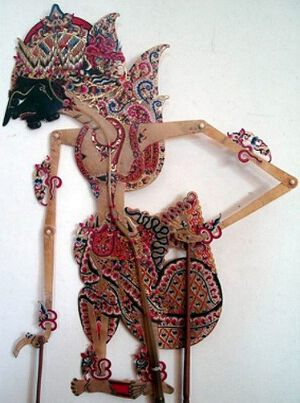Basupati - (Wayang Kulit)
| Title | Basupati - (Prabu) - Mahabharata |
|---|---|
| Other names | Srinada, Basurata, Basuparicara, Wasupati |
| Size | 50 cm |
| Personal data | When young, Batara Srinada was known as Prabu Basurata, the son of Batara Wisnu from Kahyangan Untarasegara with Dewi Srisekar (or Dewi Sri Widowati). He had two siblings named Batara Srigati and Batara Srinadi.
In addition to the two, Basupati also had several siblings from the same father and mother, including Dewi Srihuna who married Batara Brahmanaresi and Dewi Bramananeki who married Bambang Parikenan, the son of Bathara Bremani/Brahmanaresi with Dewi Srihuna/Srihunon. Also Bambang Sitija who later became Prabu Bomanarakasura, the king of Surateleng. Prabu Basupati married Dewi Angati or Dewi Girika (Mahabharata), the daughter of Bagawan Kolagiri with Dewi Suktimati. From this marriage, he had three sons, each named; Arya Basunada, Arya Basukesti and Arya Basumurti. Prabu Basurata also married Dewi Bramanayuta, the daughter of Bathara Brahma from Kahyangan Daksinageni and became the first King of Wirata Country. From that marriage, Arya Basupati and Dewi Bramananeki were born. After marrying his daughter Dewi Bramananeki to Bambang Parikenan, Prabu Basurata decided to handed over the throne of the Wirata kingdom to his son, Arya Basunada and moksa. |
| Appearance | Because of his perseverance in meditation, Prabu Basupati became very powerful, and also knew all animal languages . He received a gift from Batara Indra in the form of a magic chariot named "Amarajaya" complete with its war flag that made him immune to all kinds of weapons. With the magic chariot Amarajaya, Prabu Basupati conquered seven countries, becoming the territory of the Wirata country. |
| Collection | Private collection |
Basupati – (Prabu) – Mahabharata
In the Sanskrit Mahabharata manuscript , the character Durgandini , the great-grandmother of the Pandavas, is known as Satyawati. This woman is the daughter of a king named Basu. In the Mahabharata manuscript that has been adapted into Old Javanese , the character Basu is also called Basuparicara.
It is said that Basuparicara one day witnessed the Suktimati river being raped by Mount Kolagiri. He kicked Kolagiri until he was thrown far away. However, Suktimati had already conceived Kolagiri's child. The river eventually gave birth to a daughter named Girika.
Girika then became Basuparicara's wife. One day Basuparicara went on an outing alone. Suddenly he remembered Girika's beauty and immediately ejaculated. He wrapped the semen in leaves and gave it to a bird named Syena to take home.
On her way to the palace, Syena was attacked by another bird who thought she was carrying a food package. The semen fell into the sea right below them. A female fish immediately devoured it and immediately became pregnant.
The female fish was then caught by a fisherman named Dasabala. Dasabala did not kill her but kept her until she gave birth, but not baby fish but a pair of human babies. After giving birth, the female fish returned to her original form, namely an angel who had been cursed, named Adrika.
Adrika returned to heaven leaving her children behind. The girl was named Durgandini (Satyawati, Lara Amis), while the boy was named Matsyapati.
Prabu Basuparicara in the Wirata Kingdom held a grand Sesaji Rajaweda ceremony attended by all palace officials, priests and hermits, and subordinate kings, including Prabu Mandrakusuma, king of Mandraka, Prabu Maneriya, king of Gandaradesa, Prabu Maheswara, king of Medang Kamulan, Prabu Danadewa, king of Gilingwesi, and Prabu Rambana, king of Pringgadani. Also present were Prabu Santanu, king of Hastina who had gained full independence as an equal partner.
In the ceremony, Prabu Basuparicara changed his title to Prabu Wasupati, while his consort Dewi Adrika changed her name to Dewi Swargandini. Raden Basuketu, who was considered successful in carrying out his duties as vice king while Prabu Wasupati was wandering, also received a new title, namely Aryaprabu Kistawa.
After the ceremony ended, Prabu Wasupati announced that starting today, all subordinate kingdoms were declared independent and no longer under the rule of Wirata. Thus, the Mandraka, Gandaradesa, Medang Kamulan, Gilingwesi, and Pringgadani Kingdoms from now on have the right to determine the course of their respective governments like the Hastina Kingdom and are no longer required to report to the Wirata Kingdom. Apparently, Prabu Wasupati did not want the Wirata – Hastina War incident that claimed the lives of Prabu Pratipa to happen again just because of the desire to excel between one kingdom and another.
The subordinate kings were touched to hear the decision. What Prabu Wasupati did was exactly the same as what Sri Maharaja Wisaka had done in the Medang Kamulan Kingdom hundreds of years ago after he succeeded in defeating Sri Maharaja Purwacandra. At that time, Sri Maharaja Wisaka freed the Gilingwesi, Purwacarita, and Wirata Kingdoms so that they were no longer under the control of Medang Kamulan.
Prabu Basupati ruled the Wirata country until he was old. Basupati handed over the throne of the Wirata Kingdom to Arya Basunada, then lived as a brahmin until he died in a state of mudra.
Source: History of Wayang Purwa - Hardjowirogo - PN Balai Pustaka – 1982
Source: albumkisahwayang.blogspot.com – 2015 - Heri Purwanto
Source: radarmadiun.jawapos.com – 2024 – Ki Damar


